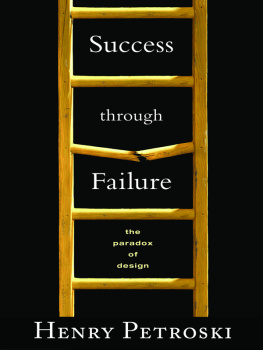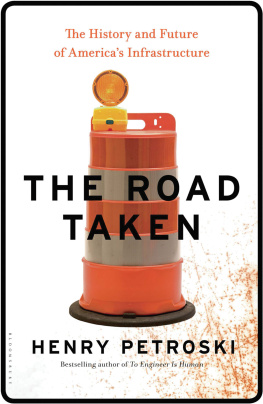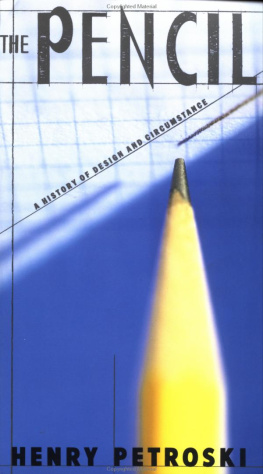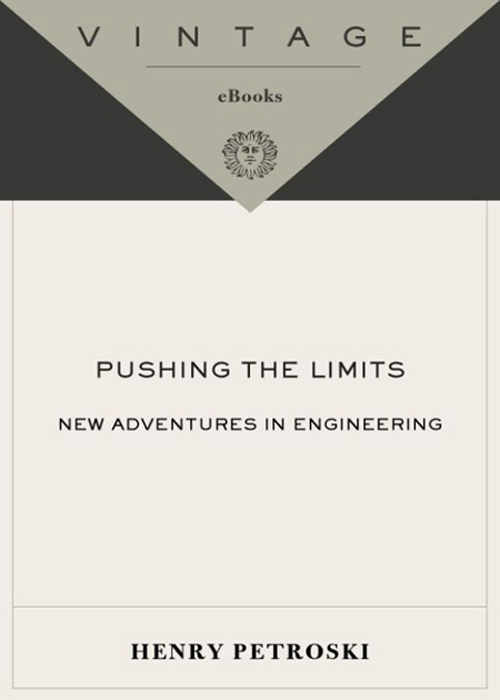
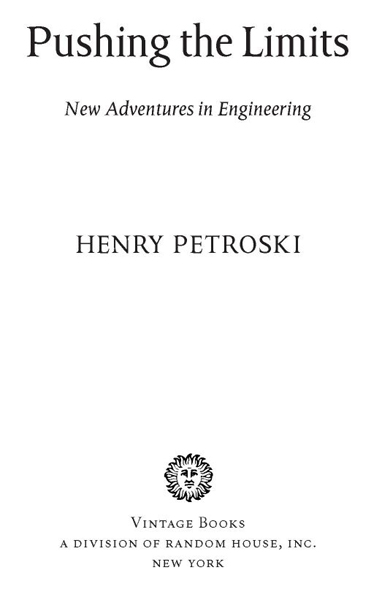
Table of Contents
to Stephen
We were put on this earth to make things.
W. H. Auden
Praise for HENRY PETROSKI
Henry Petroski has become the main emissary from the world of engineering to the rest of us.... He brings clarity and good sense to his subject, making the enigmatic world of things a little less mystifying.
Austin American-Statesman
Petroski writes... with the observant eye of an engineer and the imaginative heart of a novelist.
Los Angeles Times
An unlikely combination of mathematical brain power and a more irrational curiosity.... Petroski not only can put science in laymens terms, but also can do so without killing its magic.
The Christian Science Monitor
Petroski... asks us to see the extraordinary in the ordinary.
Chicago Tribune
[There is] pleasure [in] seeing Henry Petroskis playful mind at work.
Scientific American
Preface
Engineers are the masterminds behind most things made, from the miniaturized microelectronics device that fits into the ear to help the hard of hearing to the gigantic domed stadium into which a hundred thousand fans can crowd and cheer. Small things, large things, simple things, complex thingsthey are all the products of the minds of engineers and the hands of engineering.
Mainly, this book is a celebration of the bigger things that engineers make, the bridges and buildings and dams that are among the largest constructions on earth. The stories behind such achievements are often the stories of engineers with personalities as large as their plans, whose persistent dreams have become part of our reality.
Some of the greatest engineering achievements have been dwarfed by later ones. Thus, the first flight of the Wright Flyer was shorter than the wingspan of todays jumbo jets. And a pedestrian who in five minutes can walk between the towers of the Brooklyn Bridgeonce the longest span in the worldwould need twenty to walk from tower to tower of Japans Akashi Kaikyo Bridge, todays longest. The title of greatest is one that seldom stands unchallenged for long, but even former champions still command a measure of respect. The Empire State Building, which reigned as the worlds tallest for four decades, remains an awesome structure to which tourists flock.
Size is not the only criterion by which an accomplishment is judged. Great engineering projects, even those in the megaproject category, are not great simply because they are big. The ingenious creations and elegant solutions of engineers are also works of art and inspiration: an Eiffel Tower or a voyage to the moon lifts everyones spirits. Above all, the stories of great structures and schemes are also the stories of people, often of those who persist in the face of opposition to realize what others had declared impossible.
Making things is an activity as old as civilization, and making ever new things is part of being human. Laypersons and engineers alike are forever encountering new problems, new needs, and new desires that challenge them to invent, to innovate, and to engineer still another thing, another scheme, another dream. The accomplishments of our predecessors provide both the stick and the carrot to keep us goingat the same time, we follow the tried-and-true ways and deviate from them. As footpaths evolved into roads, so roads developed into highways, but what the highways of the future will be like is unimaginable to most of us today.
The older is not always a reliable model for the newer, the smaller for the larger, or the simpler for the more complex, as countless failures and embarrassments throughout the history of civilization have demonstrated. Such temporary setbacks and disappointments are an integral part of progress, but they occur remarkably infrequently even in the face of the most difficult of challenges. Making something greater than any existing thing necessarily involves going beyond experience. This book is about such adventures in engineering: testing the boundaries, moving the frontier, pushing the limits.
Bridges
Art in Iron and Steel
Works of engineering and technology are sometimes viewed as the antitheses of art and humanity. Think of the connotations of assembly lines, robots, and computers. Any positive values there might be in such creations of the mind and human industry can be overwhelmed by the associated negative images of repetitive, stressful, and threatened jobs. Such images fuel the arguments of critics of technology even as they themselves may drive powerful cars and use the Internet to protest what they see as the artless and dehumanizing aspects of living in an industrialized and digitized society. At the same time, landmark megastructures such as the Brooklyn and Golden Gate bridges are almost universally hailed as majestic human achievements as well as great engineering monuments that have come to signify the spirits of their respective cities. The relationship between art and engineering has seldom been easy or consistent.
Arguably, the assembly-line process associated with Henry Ford made workers tools of the system, but Ford also wanted to produce automobiles that were affordable to working people, and he paid his own workers sufficiently well that they could save to buy the cars they made. The human worker may have appeared to be but a cog in the wheel of industry, yet photographers could reveal the beauty of line and composition in a worker doing something as common as using a wrench to turn a bolt. When Fords enormous River Rouge plant opened in 1927 to produce the Model A, the painter-photographer Charles Sheeler was chosen to photograph it. The worlds largest car factory captured the imagination of Sheeler, who described it as the most thrilling subject he ever had to work with. The artist also composed oil paintings of the plant, giving them titles such as AmericanLandscape and Classic Landscape.
Long before Sheeler, other artists, too, had seen the beauty and humanity in works of engineering and technology. This is perhaps no more evident than in Coalbrookdale, England, where iron, which was so important to the industrial revolution, was worked for centuries. Here, in the late eighteenth century, Abraham Darby III cast on the banks of the Severn River the large ribs that formed the worlds first iron bridge, a dramatic departure from the classic stone and timber bridges that dotted the countryside and were captured in numerous serene landscape paintings. The metal structure, simply but appropriately called Iron Bridge, still spans the river and still beckons engineers, artists, and tourists to gaze upon and walk across it, as if on a pilgrimage to a revered place.
At Coalbrookdale, the reflection of the ironwork in the water completes the semicircular structure to form a wide-open eye into the future that is now the past. One artists bucolic depiction shows pedestrians and horsemen on the bridge, as if on a woodland trail. On one shore, a pair of well-dressed onlookers interrupt their stroll along the riverbank, perhaps to admire the bridge. On the other side of the gently flowing river, a lone man leads two mules beneath an arch that lets the towpath pass through the bridges abutment. A single boatman paddles across the river in a tiny tub. He is in no rush because there is no towline to carry from one side of the bridge to the other. This is how Michael Rooker saw Iron Bridge in his 1792 painting. A colored engraving of the scene hangs in the nearby Ironbridge Gorge Museum, along with countless other contemporary renderings of the bridge in its full glory and in its context, showing the iron structure not as a blight on the landscape but at the center of it. The surrounding area at the same time radiates out from the bridge and pales behind it.
Next page



